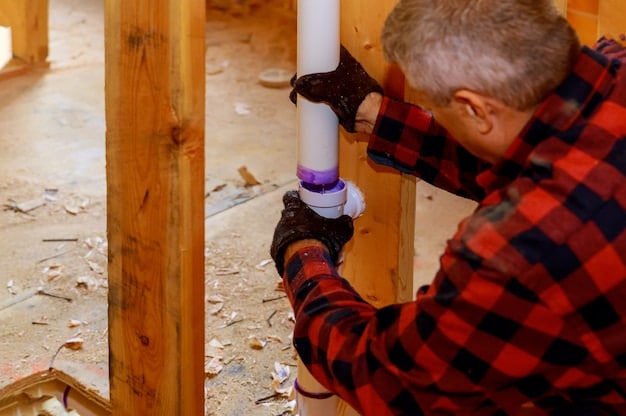Winter Storm Preparedness: Secure Your Home and Vehicle Before the Freeze

Winter storm preparedness involves protecting your home and vehicle from freezing temperatures through insulation, maintenance, and stocking up on essential supplies to ensure safety and minimize damage.
As winter approaches, ensuring your home and vehicle are ready for the harsh weather isn’t just a matter of convenience; it’s a matter of safety. Winter storm preparedness: how to winterize your home and vehicle before the first freeze is essential to protect your property and loved ones from the damaging effects of severe winter conditions.
Understanding the Risks of Winter Storms
Winter storms can bring a variety of hazards, from heavy snow and ice to freezing rain and extreme cold. Understanding these risks is the first step in effectively preparing for them.
Common Winter Weather Hazards
Winter storms can manifest in several dangerous forms. Being aware of these will help you take appropriate precautions.
- Heavy Snow: Can cause power outages, make travel impossible, and even lead to roof collapses.
- Ice and Freezing Rain: Creates slippery conditions, making walking and driving treacherous.
- Extreme Cold: Can lead to hypothermia and frostbite in humans and pets, as well as frozen pipes in homes.
Why Preparation is Crucial
Being prepared for a winter storm can significantly reduce the risk of injury, property damage, and discomfort. It also allows you to handle emergencies more effectively.
Taking the time to winterize your home and vehicle is an investment in your safety and peace of mind. Simple actions like insulating pipes, checking tire treads, and stocking up on emergency supplies can make a big difference.
Ultimately, winter storm preparedness is about being proactive. By understanding the risks and taking steps to mitigate them, you can face the winter season with confidence.
Winterizing Your Home: A Room-by-Room Guide
Protecting your home from the freezing temperatures requires a comprehensive approach. Here’s a room-by-room guide to ensure your house is ready for winter.

Insulating and Sealing
Proper insulation and sealing are critical for preventing heat loss and reducing energy bills during the winter months.
Start by checking the insulation in your attic, walls, and crawl spaces. Add more insulation if necessary. Seal any cracks or gaps around windows, doors, and pipes using weather stripping or caulk. Install storm windows or cover windows with plastic sheeting to add an extra layer of insulation.
Protecting Pipes
Frozen pipes can burst and cause significant water damage. Taking preventative measures is essential.
- Insulate Exposed Pipes: Use foam or fiberglass sleeves to insulate pipes in unheated areas like basements and crawl spaces.
- Seal Cracks and Openings: Seal any cracks or openings around pipes to prevent cold air from entering.
- Let Faucets Drip: On extremely cold nights, let faucets drip slightly to keep water moving through the pipes.
In conclusion, winterizing your home room by room involves insulating, sealing, and protecting pipes. These measures can prevent heat loss, reduce energy costs, and minimize the risk of water damage.
Preparing Your Vehicle for Winter
Your vehicle needs special attention to ensure it can handle the harsh weather conditions. Here’s how to prepare your car or truck for winter.
Essential Winter Vehicle Maintenance
Regular maintenance is even more critical in winter. Make sure your vehicle is in top condition before the first freeze.
Check your battery to ensure it has sufficient charge. Cold weather reduces battery power. Inspect your tires and ensure they have adequate tread. Consider using winter tires for better traction. Check all fluids, including antifreeze, oil, and windshield washer fluid.
Stocking an Emergency Kit
An emergency kit can be a lifesaver if you get stranded in a winter storm. Be sure to include a few important items.
- Blankets: For warmth.
- Flashlight: With extra batteries.
- First Aid Kit: For minor injuries.
- Snacks: High-energy foods like granola bars.
Preparing your vehicle for winter involves essential maintenance and stocking an emergency kit. These steps ensure your vehicle is ready to handle winter conditions and that you’re prepared for unexpected situations.
Creating a Home Emergency Supply Kit
Having an emergency supply kit is crucial for weathering a winter storm. Here’s what you need to include to stay safe and comfortable.

Essential Supplies
Your emergency kit should include items that will help you stay safe and comfortable during a power outage or other emergency.
Stock up on non-perishable food items like canned goods, dried fruits, and nuts. Ensure you have enough water for drinking and sanitation. Include a first aid kit, flashlight, battery-powered radio, and extra batteries.
Heating Alternatives
If the power goes out, you’ll need alternative ways to stay warm. Choose heating alternatives carefully.
- Fireplace: If you have one, make sure it’s in good working condition and you have a supply of wood.
- Portable Heater: Use electric or propane heaters with caution, ensuring proper ventilation.
- Warm Clothing: Dress in layers to stay warm even without power.
Creating a home emergency supply kit with essential supplies and heating alternatives ensures you’re prepared to handle winter storms and power outages safely and comfortably.
Staying Safe During a Winter Storm
Knowing what to do during a winter storm is just as important as preparing for one. Here’s how to stay safe when the weather turns severe.
During the Storm
Stay indoors and avoid unnecessary travel if possible. Monitor weather reports and heed any warnings from local authorities.
Keep indoor temperatures as warm as possible. If you lose power, close off unused rooms and stuff towels or rags in cracks under doors to keep out drafts. Wear layers of warm clothing to stay comfortable.
After the Storm
Once the storm has passed, take steps to ensure your safety and assess any damage.
- Shovel Snow: Clear walkways and driveways, but avoid overexertion.
- Check for Damage: Inspect your home for any signs of damage, such as broken pipes or roof leaks.
- Help Neighbors: Check on elderly or vulnerable neighbors who may need assistance.
Staying safe during and after a winter storm involves staying informed, taking precautions indoors, and addressing any damage promptly. Helping neighbors can also make our communities more resilient.
Long-Term Preparations and Investments
Some winter weather preparations require more planning and investment. Consider these long-term strategies to enhance your winter resilience.
Home Improvements
Certain home improvements can significantly improve your home’s ability to withstand winter weather. When done correctly, the investment pays off long-term.
Consider upgrading your home’s insulation to reduce heat loss. Replace old windows with energy-efficient models. Install a generator for backup power during outages.
Community Planning
Engaging with your community can enhance overall preparedness. Communicate your needs and learn how you can help your community.
- Emergency Services: Familiarize yourself with local emergency services.
- Community Resources: Check what resources are available in your community.
- Assistance Programs: Know what assistance programs are available for vulnerable members of your community.
Long-term preparations and investments in home improvements and community planning can enhance your overall resilience to winter weather and ensure your safety and comfort for years to come.
| Key Point | Brief Description |
|---|---|
| 🏠 Insulate Your Home | Seal windows/doors, insulate pipes to prevent freezing. |
| 🚗 Vehicle Check-Up | Battery, tires, fluids – ensure your car is winter-ready. |
| 🎒 Emergency Kit | Food, water, blankets, and a first-aid kit. |
| 🔥 Heating Alternatives | Plan for power outages with safe heating solutions. |
Frequently Asked Questions
▼
Insulate exposed pipes, seal cracks near pipes, and let faucets drip during extremely cold nights. These steps keep water moving and prevent freezing.
▼
Include blankets, a flashlight, a first aid kit, high-energy snacks, and jumper cables. These items can help you stay safe if you get stranded.
▼
Insulate your attic, walls, and crawl spaces. Seal cracks around windows and doors. Install storm windows or use plastic sheeting to add insulation.
▼
Common dangers include heavy snow, ice, freezing rain, extreme cold, and power outages. These can lead to injuries, property damage, and discomfort.
▼
Check your tire pressure and tread depth at least once a week. Cold weather can cause tire pressure to decrease, affecting handling and safety on icy roads.
Conclusion
Taking proactive steps to winterize your home and vehicle before the first freeze is paramount for staying safe and comfortable throughout the winter season. With proper preparation, you can mitigate risks, minimize damage, and ensure your well-being during severe weather conditions.





